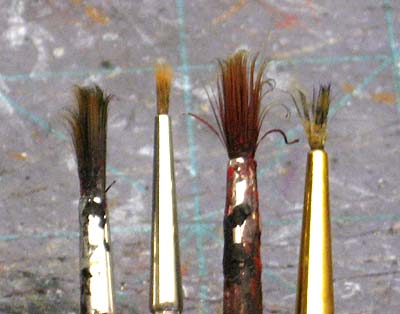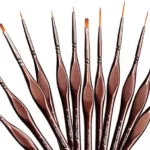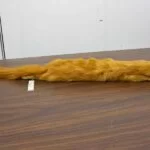keep Your paintbrushes pointed (and reshape damaged brushes)

From wrong use to shipping defects, paint brushes can get damaged fast.
Keeping synthetic paintbrushes pointed is never an easy task that can be even harder if you are using kolinsky sable (natural hair) brushes.
Most painters would think they have experience painting their miniatures and skip some care techniques that ensure their paintbrushes last long, but the truth is that paintbrushes are tools you need to take good care for.
Just follow this guide to ensure your paint brushes stay pointed and in the best form for a long time.
The no. 1 Reason paint brushes’ points get messy
(no matter if its synthetic or natural hair paintbrush)
Two of the biggest reasons paint brushes easily get damaged are that people use them wrongly, or the fault could be from the courier service, especially if you just got them out of the box.
First, when using your brush, understand that the brush stroke matters.
You don’t want to be pushing with the tip of your brush when you use the brush. Instead, you want to use the side of the tip to paint.
Pushing down with the pointed part of the brush will make the bristles split. With wrong use, the bristles break and change their form.
Kolinsky sable bristles are more delicate than synthetic bristles and applying too much pressure on them will damage them quickly.
The 2nd reason that brushes’ points get damaged
Another way to mess up your paintbrush is to allow the paint to dry up in the ferrule. Dried-up paint pushes the hair of the brush outwards.
Sometimes the tips of your brush get damaged in shipping or just a bad brush due to craftsmanship defects. When this happens, most people feel bad about getting defective products, when they have spent so much on the brush.
The good news is that you can always reshape and restore your brush when they damage due to dried paint or shipping mishaps.
How to use your paintbrush correctly (and keep the tip pointed)
Whether you are using a kolinsky sable brush or a synthetic brush, ruining the tip of your brush is super easy.
The first rule is to buy a good brush. No matter how well you feel you use a brush, cheap brushes will damage easily. So, get quality brushes, most preferably, series no.7 brushes that the tip won’t spoil. The next thing to consider is to take care of the brushes well.
The second rule to remember is to pull the brush in sweeping motions rather than push or stab it. Besides this, avoid dipping a dry brush into paint; always wet it first so that it keeps its pointed tip.
Also, be sure to change the water regularly so that the pigments in the water don’t clog the root of the brush and stop the brush from returning to its shape. This is more common with smaller-size paintbrushes.
Another tip to remember is to never store brushes without twirling the tip, especially natural hair brushes. Twirl them with a restorer after washing so that the tip remains pointed.
How to reshape synthetic or sable paintbrush bristles due to wrong use
So, if you have a messy paint brush due to wrong use, a good technique to reshape them is to use a brush restore like the Master’s brush cleaner and restorer to keep the tips pointy.
- Pour a bit of the cleaner on your hand and gently rub it over the bristles
- Rinse your hand and the brush, and pour a little more of the soap
- Roll the brush in a line in your palm or use your fingers to carefully shape it.
- Do not wipe the soap off the brush and dry with the brush point up. This allows the brush to dry to a stiff point.
The advantage of using a brush restorer on synthetic brushes is that it acts as a conditioner. To keep your brush pointy, you need a soap medium or conditioner. Like a conditioner, if you lather the brush with the brush restorer, it makes the bristles soft and stays in shape.
How to reshape paint brush bristles due to courier mishaps
If the bristles of your synthetic or natural hair paintbrush get messy from shipping mishaps, the best way to reshape them will be soaking them in a thinner and using motor oil to get them pointy. To do this,
- Pour thinner into a pot and soak the brush for 10 minutes to get the brush soft
- Run brush soap over the bristles and comb the hair, so it gets soft and untangled
- Clean with the thinner again
- Then work in a plain motor oil paying special attention to the tips
- Use your finger to twirl the tip so that it stays pointed, and let it dry.
A brush tip damaged due to shipping mishaps often won’t become pointy again since they already have a burnt form that needs extra care. So, when you soak the brush in thinners, it softens the brush, so they regain its straight shape. To keep them pointy, motor oil will come in handy since they are designed to make things loose and feel extra soft.
Another consideration for storing paint brushes is to stick them to a wall or desk using a blue tak. It saves you time searching for the brush when needed while keeping the tips free from hard surfaces that may damage their tips.
Reshape your paint brushes with an egg white
I know this sounds weird, but you really should give it a try. using an egg white you can reshape your brushes easily.
all you need to do is:
- dip the tip of the brush in boiling water for few seconds.
- Reshape the bristles and get it back in the boiling water.
- without touching the bristels with your fingers, dip it in an egg white and let it sit for a couple of days.
- wash it after 48 hours and its ready to use.
The egg white sticks the bristles to each other again, giving your brush the tip back.
Instead of dipping your paintbrush in an egg white, you can dip it in gum arabic (Winsor&Newton sells one)
Reshape your brushes the IFixIt way
*I never tried it because whenever I have a damaged tip my ways work, but if it didn’t help you, maybe this will;
This is a word-to-word guide from IFixIt that I found during the research for this article.
Step 1 Repairing Paint Brush Bristles
- Identify the brush type and the level of damage:
- If the brush hairs are inflexible due to hardened paint coats, proceed to Step 2.
- If the brush hairs are synthetic (fraying bristles), proceed to Step 5.
Step 2
- Fill a small cup halfway with turpentine.
- Soak the brush in the turpentine for 2 days.
- CAUTION: Do this in a well-ventilated area. The fumes from turpentine are toxic.
Step 3
- Remove any amount of paint that may remain on the brush by moving the brush in a circular motion.
Step 4
- To remove remnants of turpentine on the bristles, wash the brush thoroughly in water.
- After the turpentine has been completely removed, proceed to Step 7.
Step 5
- For synthetic brushes, boil a pot of water.
- CAUTION: Avoid any contact with hot objects.
Step 6
- Place the brush in the boiling water.
- Rotate the brush in the water for approximately 5 minutes.
- You should begin to notice that the bristles will start to come back together from the heat and water.
Step 7
- Gently dry off the brushes using a soft towel.
- Stroke the brush in an upward motion and be careful not to dig the towel through the bristles.
Step 8
- In order to retain the brush shape, use a brush tube or wrap the bristles in aluminum foil.
- Within approximately three hours, the brush bristles will be back to normal.
Step 9
- Cut off excess frayed bristles (optional).
- There may be a few fraying bristles left. These are harmless and will cling to the brush shape when dipped in paint.
- If preferred, you may use a nail clipper to cut these hairs off.
How to take care of your brushes so that they keep their shape
How you care for your brush will determine whether they last long or damage only a few days after buying one. So, to care for your brushes here’s what you need to do.
- Never let paint cover the brush up to the metal ferrule. Once paint gets in the ferrule, it will mess up its shape. If the paint gets into the metal ferrule, there’s almost no way to stop them from splitting in the future. If you want to get paint further up the side of the brush, use an old brush to take the paint from the pot to your palette and water it down, then when it’s nice and thin, use your detail brush.
- Keep them moist throughout (wet pallets are good), and shape the tips regularly, so they don’t lose their pointy edge.
- If you’re using the bristle to mix paint, try mixing it with the other end so the brush won’t damage from you trying to fit it in the paint can.
- Never store your brush’s tip down. After washing, don’t leave them sitting there as they will bend quickly. Instead, store them tip up, in a tin or pencil, or at the very least horizontally.
How to store your brushes Correctly
Brushes can lose their shapes quickly, especially when you leave them to dry in the wrong position.
A good way to maintain their shapes and keep them long-lasting is to keep them upright. Don’t ever leave them facing downwards in water for long. Also, consider getting a container like a miniature paintbrush holder to put the brushes. It makes sorting the brushes easy while keeping the paintbrush well.
Another consideration for storing paint brushes is to stick them to a wall or desk using a blue tak. It saves you time searching for the brush when needed while keeping the tips free from hard surfaces that may damage their tips.
Conclusion
If you’re a new painter and recently picked a paintbrush to try on your model, it means you’ll probably experience losing the pointed edges of your paintbrush since you don’t really know how to care for the brush.
Paint brushes can become frazzled in no time. We hope that this guide on how to keep paint brushes pointed will help make caring for your brushes easy. Otherwise, read our previous article on “How to Care for a Kolinsky Sable Brush” to learn more about caring for natural paint brushes.





